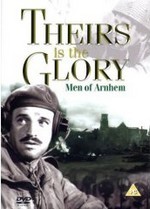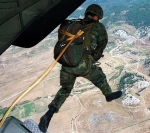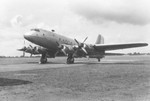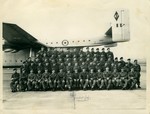When I was a small boy, probably about 10 or 12, I saw a film about the battle of Arnhem which took place in September 1944. In this battle, code-named Market Garden the 1st Airborne Division had to take and hold a bridge over the Lower Rhine at the Dutch city of Arnhem. The 2nd battalion captured the bridge and awaited the arrival of the British 2nd Army. They had been told that they would reach them in 3 days, but the the main British Army failed to get through, and after 9 days the 2nd Battalion were forced to surrender as they had run out of ammunition. It was a story of great heroism and it stirred me.

The story of this battle later was told again in the Hollywood Blockbuster A Bridge Too Far, but the film I saw was called Theirs Is The Glory and it was made just after the war, about 1946, in the ruins of Arnhem, without actors, but with the survivors who had actually been there.
When I went to London University, I tried to join the University Air Squadron, but was turned down. A few weeks later, still smarting from the rejection, I went to Roomes Stores in Upminster, a large department store and in the lobby there was an exhibition by the local TA which happened to be an airborne unit. To join the TA for me made sense for at the time I was due to do National Service and as a student the very good pay offered for one night a week and one week-end a month would supplement my student grant. More important I would have a chance to do the 2 week parachute training course at
Abingdon just like any Red Devil as the men at Arnhem were called by their German adversaries.
I joined up and during the following Easter holidays went off to the British Army Parachute School at Abingdon, near Oxford.
I was 18 at the time and those 2 weeks rank as one of the most exciting times of my life.
There were about 50 of us, all weekend soldiers and I remember arriving and being marched to our barracks by a fierce looking Para Sergeant. There was a group of regular Paras living above us and we were told to keep away from them and not to mess with them as they were very tough. They certainly were. They seemed to be physically small men, but wiry looking with a certain determined look in their eyes. Our only contact was during meal times when we all queued up together.
Then a funny incident. The Sergeant issued us with mattresses and he ordered us to inspect ours to see that "they ain't been urinated" because when we handed them back in two weeks time, they would be inspected and if they "had been urinated" we would have to pay for their replacment.
The only army type discipline was marching to the training areas and I was pleasantly surprised to find that our instructors were RAF sergeants who were very friendly. Our 12 man section was trained by Sergeant Smith.
We did all our training inside a large hangar. It was important to learn how to hit the ground properly. Modern parachutes can be controlled and allow one to land gently on ones feet, but in those days military type parachutes were mushroom shaped and descended faster. Remember, somebody might be shooting at you!
The tecnique is to land on your feet then immediately roll which dissipated the energy over the parts of the body which can stand a knock. For example over the outside of the legs then diagonally across the back and shoulder, finally swinging your legs over. It was important to learn to tuck your chin into the chest. Even though we had padded steel helmets, a floppy head hitting the ground as you roll backwards meant concussion. We practised and practised. It wasn't too difficult for me as I was very fit in those days and had learnt judo which also involves learning to fall without injury.
All of this training paid off later as I stepped into the road, without thinking, into the path of a car travelling luckily at only about 20mph. As I saw it coming I jumped into the air, the car hit the sides of my legs and I rolled over the bonnet and landed on the pavement. Passers-by rushed over expecting to find a corpse or badly injured casualty, but I had no broken bones or bruises and was able to walk to my car and continue to my next factory visit. As I went over the bonnet I cut the inside of my arm on the radio aerial which had been broken off (this was common in Venezuela). I hadn't even realised as the adrenilin neutralised the pain.
Another part of training in the hangar was to hang from the ceiling in a parachute harness and learn to make adjustments to the various straps whilst swinging from side to side.
We also practised the movements inside an aircraft. An old aircraft fuselage was inside the hangar so we were able practise jumping through the door onto a mat.
In 2 weeks we had to get to the point where 30 men with 80 lbs of equipment each could exit an aircraft in 10 seconds. There were 2 exit doors to the rear so we moved down the fuselage in two rows of 15 men.
We practised and practised for 3 days when we were told that our first jumps would be on the thursday morning. That morning you had to queue for the toilets as most were more scared of pooing their pants with fear than of leaping out into space on the end of a line.
Several of our group had jumped already as we watched from the ground below, then it was my turn. We entered the gondola and it was gradually winched upwards to 800ft. Sergeant Smith told us that he would tell a joke on the way up, which took about 10 minutes, and that he guaranteed that we would be so scared that nobody would laugh. He told a joke and nobody laughed.
The balloon reached its height and he removed the bar across the exit door. The order came, number 1 stand in the door, ready and then the hard slap on the shoulder and number 1 went out. Then it was my turn. I felt practically paralysed and my legs were like jelly, he gave the order and I stood in the door and I was out. This is where the constant training kicks in. I am sure that it is physically impossible not to jump out as you automatically obey the orders.
There was a sickening falling sensation when my stomach rose up into my chest, then a crack and a jerk as the parachute deployed. The feeling at that point was absolute bliss. There is no sensation of falling, just that little figures and vehicles on the ground just get bigger and bigger.
At about 100 ft from the ground I went through the landing procedure and I was on the ground. I scooped up my parachute and walked to my group feeling 10 ft tall! They say that parachuting is the second greatest thrill known to man.
To see a short youtube clip of a balloon jump click here.
We did 2 more balloon jumps that week. The reason for jumping from a balloon at the beginning is to avoid the problems that can occur when leaping out of the door of a plane when you hit the 120mph slipstream, plus the fact that it is cheaper.
To our surprise we were given train passes on friday afternoon to go home for the weekend. On monday and tuesday the weather was unsuitable, but on wednesday we boarded a Hastings for our first airplane jump.
I had never flown in my life before and they told us that this was a trip round to get used to flying. After a while we got the order to stand up and we started to jump, so my first flight was unusual.
Jumping from an airplane is heavenly as you do not get the sickening drop. The slip stream grabs you and you are in the air on your back, it was like being on a feather bed. Your parachute separates from the static line and whips over your head, opens with a crack in front and you then swing under it.
We did a couple more jumps from a Hastings and a jump from the Beverley which was then the RAF's latest transport aircraft. It had a drop down ramp at the rear to drop large pieces of equipment as well as men from the side doors. The tail was also used for dropping men, but through a hole in the floor instead of the side doors. I did a jump from the tail which requires walking down the passage way and just stepping into a hole.
In order to get our wings we had to complete 8 jumps. As we had to rely on good weather the last thursday was a beautiful sunny and calm day, so they decided that we should try and get in our last three drops that day if possible. It was amazing. Into the lorry for a short drive to the airfield. Get in the plane, a short flight to the dropping zone, jump out, back into the lorry, get a new 'chute, in the plane again. We did our three remaining jumps and at 4 in the afternoon they presented us with our wings.The Squadron Leader in charge of the school congratulated us as we were one of the only groups who completed the course to a man. Always there are a few who give up after a few jumps. There is no shame in this and we were told that at any time we wanted out, the office would give us our train ticket and take us to the station. The others in the group would not know anything until the end of the day.
The last jumps were more complicated as we had to carry full kit. In the days of Arnhem, all equipment was dropped separately in canisters so very often men and equipment landed hundreds of yards away or was lost, so in the 50's you jumped with your rifle and ammo and kit in a frameless rucksack that was attached to your harness at about waist level with a strap round one leg. You jumped out and on the way down released the leg strap then flicked the 2 catches at the waist and the kitbag fell away. The kitbag then remained suspended about 12 ft below on a thin cord attached to your harness. The extra weight made the descent faster, but as the kitbag touched the ground first, its weight was neutralised and your landing was normal. except that you had to avoid landing on top of the bag. This was done by pulling on the rigging lines to one side so that you hit the ground at an angle and not vertically. This all required a lot of quick thinking and spoiled the beauty of jumping as there was no time to admire the scenery.
During that summer, the 16th Independent Parachute Brigade of which our Royal Artillery squadron was a part of, went to Thetford in Norfolk for 2 weeks summer camp. There we took part in a war game which involved dropping as a large group. It was very exciting as 180 of us dropped in a field together using 6 Hastings aircraft. This was the nearest we could get to the real thing.
We had a 4 inch mortar mounted on a trailer towed by a jeep. Each jeep carried the 5 man crew for the mortar.
As this was an exercise, our jeep and its trailer was already at the end of the dropping zone mounted on its platform, just as it would be if it had been dropped with us.
We landed in this field with thick,long grass and had to make our way to a tree which was the marker and where our jeep was. As it was hard going through the grass and it was a hot sunny summers day, my mate and I decided to go along a road running alongside the drop zone. It so happened that my mate was a veteran of Arnhem, he was a worker with my Dad's building company, about 30 years old.
As it was quite a spectacle, there were a lot of cars and sightseers on the road, including an ice cream van. My mate and I couldn't resist it and we bought ourselves an ice cream each. "Did you have ice cream vans at Arnhem?" I asked him. "If there were any I did'nt see one" he replied ruefully. When we arrived at the jeep our officer was quite angry! We spent the night sleeping out and in the morning attacked the enemy. Once again I was made aware that a real battle is just total confusion. We were driving down a road when we were ambushed. All these rifles appeared from the windows of a few derelict houses and started shooting at us. (blanks luckily). We did a U turn and fled. Later an umpire came and said we were all dead so it was just as well I never had to fight a real war.
I did a total of 13 jumps with the TA before leaving them to pursue new interests.
A few years ago driving from the Hook of Holland ferry to visit our son Andrew in Germany we drove on the motorway just north of Arnhem, just about where the dropping zone was way back in 1944. I must admit that the hairs on the back of my neck tingled at the thought of where I was and of all those men who died there.


